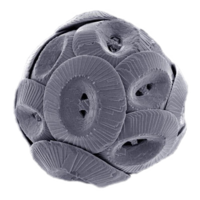Marine biogenic calcification

Okay kiddo, let's talk about marine biogenic calcification! Have you ever heard of the word 'calcium'? It's a mineral that helps to build strong bones and teeth. Just like how we need calcium, marine animals like corals, mollusks, and some plankton also need calcium to build their shells and skeletons.
You know how some animals have hard bones? Well, marine animals build hard shells and skeletons made of calcium carbonate, which is a fancy way of saying it's made of calcium and a special kind of gas called carbon dioxide. This process of building hard shells and skeletons is called 'biogenic calcification'.
Why do these animals need hard shells and skeletons made of calcium carbonate, you ask? Well, it's because they use them for protection from predators, a place to attach themselves to so they don't get washed away by waves, and for support to help them float or swim.
But here's where it gets tricky, kiddo: the acidity of the ocean affects marine biogenic calcification. When there's too much carbon dioxide in the air, it gets absorbed into the ocean and makes it more acidic. When the ocean is more acidic, it makes it more difficult for marine animals to build their hard shells and skeletons. It's kind of like trying to build a sandcastle with wet sand - it just doesn't stay together as well.
This is why it's important for us to take care of our planet and reduce carbon emissions. By doing our part to protect the planet, we can help ensure that marine animals can continue to build their shells and skeletons and thrive in their underwater homes.
You know how some animals have hard bones? Well, marine animals build hard shells and skeletons made of calcium carbonate, which is a fancy way of saying it's made of calcium and a special kind of gas called carbon dioxide. This process of building hard shells and skeletons is called 'biogenic calcification'.
Why do these animals need hard shells and skeletons made of calcium carbonate, you ask? Well, it's because they use them for protection from predators, a place to attach themselves to so they don't get washed away by waves, and for support to help them float or swim.
But here's where it gets tricky, kiddo: the acidity of the ocean affects marine biogenic calcification. When there's too much carbon dioxide in the air, it gets absorbed into the ocean and makes it more acidic. When the ocean is more acidic, it makes it more difficult for marine animals to build their hard shells and skeletons. It's kind of like trying to build a sandcastle with wet sand - it just doesn't stay together as well.
This is why it's important for us to take care of our planet and reduce carbon emissions. By doing our part to protect the planet, we can help ensure that marine animals can continue to build their shells and skeletons and thrive in their underwater homes.
Related topics others have asked about:
